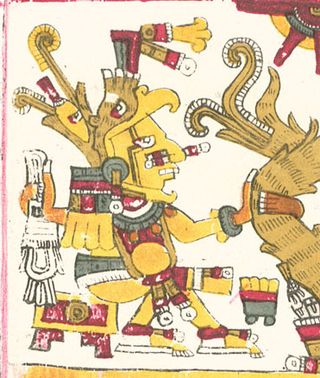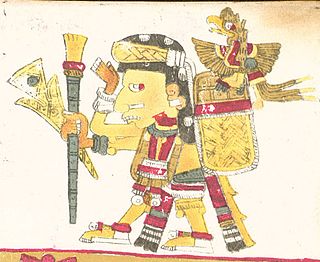
Aztec mythology is the body or collection of myths of the Aztec civilization of Central Mexico. The Aztecs were Nahuatl-speaking groups living in central Mexico and much of their mythology is similar to that of other Mesoamerican cultures. According to legend, the various groups who were to become the Aztecs arrived from the north into the Anahuac valley around Lake Texcoco. The location of this valley and lake of destination is clear – it is the heart of modern Mexico City – but little can be known with certainty about the origin of the Aztec. There are different accounts of their origin. In the myth the ancestors of the Mexica/Aztec came from a place in the north called Aztlan, the last of seven nahuatlacas to make the journey southward, hence their name "Azteca." Other accounts cite their origin in Chicomoztoc, "the place of the seven caves," or at Tamoanchan.

In Aztec mythology, Xochiquetzal, also called Ichpochtli Classical Nahuatl: Ichpōchtli[itʃˈpoːtʃtɬi], meaning "maiden"), was a goddess associated with fertility, beauty, and love, serving as a protector of young mothers and a patroness of pregnancy, childbirth, and the crafts practiced by women such as weaving and embroidery. In pre-Hispanic Maya culture, a similar figure is Goddess I.

Xōchipilli[ʃoːt͡ʃiˈpilːi] is the god of art, games, dance, flowers, and song in Aztec mythology. His name contains the Nahuatl words xōchitl ("flower") and pilli and hence means "flower prince".

In Aztec mythology, Centeōtl[senˈteoːt͡ɬ] is the maize deity. Cintli[ˈsint͡ɬi] means "dried maize still on the cob" and teōtl[ˈteoːt͡ɬ] means "deity". According to the Florentine Codex, Centeotl is the son of the earth goddess, Tlazolteotl and solar deity Piltzintecuhtli, the planet Mercury. He was born on the day-sign 1 Xochitl. Another myth claims him as the son of the goddess Xochiquetzal. The majority of evidence gathered on Centeotl suggests that he is usually portrayed as a young man, with yellow body colouration. Some specialists believe that Centeotl used to be the maize goddess Chicomecōātl. Centeotl was considered one of the most important deities of the Aztec era. There are many common features that are shown in depictions of Centeotl. For example, there often seems to be maize in his headdress. Another striking trait is the black line passing down his eyebrow, through his cheek and finishing at the bottom of his jaw line. These face markings are similarly and frequently used in the late post-classic depictions of the 'foliated' Maya maize god.
Ixtlilton in Aztec mythology is a god of medicine and healing and therefore was often alluded to as the brother of Macuilxochitl, the god of well-being or good luck. Ixtlilton was a gentle god, who emanated from an obsidian mask which brought darkness and peaceful sleep to children in their beds at night.
Opochtli was one of the gods of the Aztec pantheon. He was considered the god of fishing and hunting, as well as one of the representatives of the rain god Tlaloc. In Nahuatl, his name means The Left or The Left-Handed. He was the god who threw his spear with his left hand. Since the Aztecs saw the west as the primary cardinal point, the south was on the left according to their orientation. Opochtli was therefore also associated with the south. He is said to have invented the atlatl, the net, the canoe pole, and the bird snare.

In Aztec mythology, Xipe Totec or Xipetotec was a life-death-rebirth deity, god of agriculture, vegetation, the east, spring, goldsmiths, silversmiths, liberation, and the seasons. The female equivalent of Xipe Totec was the goddess Xilonen-Chicomecoatl.

The Nahua people, also academically referred to as Pipil, are an indigenous group of Mesoamerican people inhabiting the western and central areas of present-day El Salvador. Although very few speakers are now left, they speak the Nawat language, which belongs to the Nahuan language branch. Indigenous accounts recorded by Spanish chronicler Gonzalo Francisco de Oviedo suggest that the Nahuas of El Salvador migrated from present-day Mexico to their current locations beginning around the 8th century A.D. As they settled in the area, they founded the city-state of Kuskatan, which was already home to various groups including the Lenca, Xinca, Ch'orti', and Poqomam.
Matlatzinca is a name used to refer to different indigenous ethnic groups in the Toluca Valley in the state of México, located in the central highlands of Mexico. The term is applied to the ethnic group inhabiting the valley of Toluca and to their language, Matlatzinca.
Juan Pedro Laporte Molina was a prominent Guatemalan archaeologist best known for his work on the ancient Maya civilization. He studied in the United States at the University of Arizona, in which he enrolled at the age of nineteen. After just one year he transferred to the Escuela Nacional de Antropología e Historia in Mexico. He continued his studies at the Universidad Autónoma de México from 1972 to 1976, from which he graduated with a doctorate in archaeology. He worked as a research assistant at the Museo Nacional de Antropología in Mexico City from 1967 through to 1976. Laporte worked at various archaeological sites while he was in Mexico, including Tlatilco, Chichen Itza and Dainzú. He first began working as an archaeologist in Guatemala in the 1970s, and was the head of the School of History of the Universidad de San Carlos de Guatemala (USAC) for more than thirty years. He first entered USAC in 1977, soon after returning from Mexico. In 1974 he carried out investigations at the Maya archaeological site of Uaxactun in the northern Petén Department of Guatemala. Between 1974 and 1976 he carried out archaeological investigations in Antigua Guatemala, which has since been designated as a UNESCO World Heritage Site, and around Lake Izabal.

Zacatzontli, in Aztec mythology, is the god of day road, he has an eagle as sun's symbol guide. He holds in his left hand a staff and his right hand supports an backpack full of quetzals. He can be a protector of merchants, thus equating him with the Mayan god Ek Chuáj. One of the odd things about Zacatzontli is that he doesn't have a headdress, only a feather. His name could mean Lord of the Road or His Road The Lord, although the former seems more likely.
In Aztec mythology, the Cintēteo are the four gods of maize. They are sons of the goddess Centeōtl and the god Cinteōtl.
In Aztec mythology, Cihuatecayotl is the god of the West wind. His brothers are Mictlanpachecatl, Tlalocayotl, and Huitztlampaehecatl, who personify the winds from the north, east, and south respectively.
In Aztec mythology, Mictlanpachecatl is the god of the North wind. His brothers are Cihuatecayotl, Tlalocayotl, and Huitztlampaehecatl, who personify the winds from the west, east, and south respectively.

In Aztec mythology, Creator-gods are the only four Tezcatlipocas, the children of the creator couple Ometecuhtli and Omecihuatl "Lord and Lady of Duality", "Lord and Lady of the Near and the Close", "Father and Mother of the Gods", "Father and Mother of us all", who received the gift of the ability to create other living beings without childbearing. They reside atop a mythical thirteenth heaven Ilhuicatl-Omeyocan "the place of duality".
In Aztec mythology the Lords of the Day are a set of thirteen gods that ruled over a particular day corresponding to one of the thirteen heavens. They were cyclical, so that the same god recurred every thirteen days. In the Aztec calendar, the lords of the day are
- Xiuhtecuhtli, god of fire and time.
- Tlaltecuhtli, god of the earth.
- Chalchiuhtlicue, goddess of water, lakes, rivers, seas, streams, horizontal waters, storms and baptism.
- Tonatiuh, god of the sun.
- Tlazolteotl, goddess of lust, carnality, sexual misdeeds.
- Mictlantecuhtli, god of the underworld.
- Centeotl, goddess of maize. Also recognized as Chicomecoatl, goddess of agriculture.
- Tlaloc, god of the thunder, rain and earthquakes.
- Quetzalcoatl, god of wisdom, life, knowledge, morning star, fertility, patron of the winds and the light, the lord of the West.
- Tezcatlipoca, god of providence, matter and the invisible, ruler of the night, Great Bear, impalpable, ubiquity and the twilight, the lord of the North.
- Mictecacihuatl, goddess of the underworld.
- Tlahuizcalpantecuhtli, god of dawn.
- Citlalicue, goddess of the female stars.
In Aztec mythology Huitztlampaehecatl is the god of the South wind. His brothers are Cihuatecayotl, Tlalocayotl, and Mictlanpachecatl, who personify the winds from the west, east, and north respectively.
The Nahua people such as the Aztecs, Chichimecs and the Toltecs believed that the heavens were constructed and separated into 13 levels, usually called Topan or simply each one Ilhuicatl iohhui, Ilhuicatl iohtlatoquiliz. Each level had from one to many Lords (gods) living in and ruling them.
Omeyocan is the highest of thirteen heavens in Aztec mythology, the dwelling place of Ometeotl, the dual god comprising Ometecuhtli and Omecihuatl.







